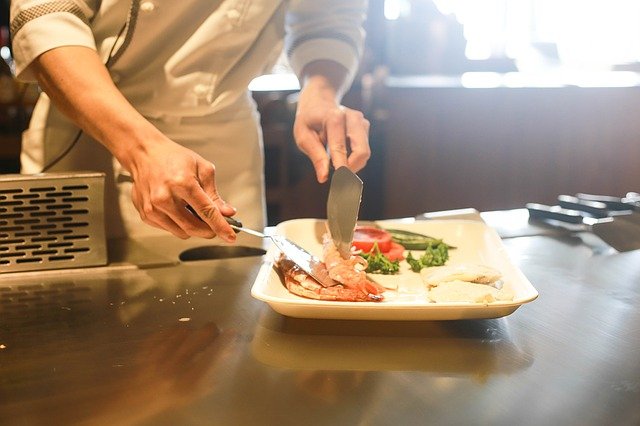If you are as busy as most people you are always looking for ways to feed your family in convenient, fast, yet not-too-expensive ways. Try the following suggestions:
- Cooking several meals for the week at one time. It may take a few hours of your time up front but will pay off in the long run when you come home each evening and have a meal ready to eat in a short amount of time. Try cooking a roast and using part of it as a main meal and then using some for sandwiches, beef stroganoff or as part of a stir-fry. Fry several pounds of hamburger and make a casserole, taco meat and chili to freeze for use later in the week.
- After you return home from the grocery store clean all the fruits and vegetables you can. When it’s time for a meal all you will have to do is cook them or add them to a salad or soup.
- Get ideas from the cooking shows on T.V. There are great shows that show you how to make a healthy meal in a short time.
- Develop a revolving recipe file. If you get bogged down by the idea of having to plan 30 meals a month the recipe file is for you. Let family members choose some of their favorites and put the recipes in a monthly file. Flip to day five or fifteen and there is the meal just waiting to be cooked.
- Enlist the help of the members of your family. As soon as the kids are old enough divide up the cooking responsibilities. Let everyone take turns with specific tasks or the whole meal. Pair these meals with fruit and veggies that have already been washed and cut-up and you are ready for dinner.
- Share the cooking with friends or neighbors. I’ve known people who cook four or five of the same meal and then trade with four or five other people. This works best when people share the same basic ideas on what they like and don’t like. It’s a great idea though for a very easy week of evening meals.

- Save coupons for those convenience things at the grocery store. They have entire entrees and dinners either fresh or frozen. Sometimes they are rather pricy but with the coupons they are good to have on hand for an evening when everyone is running in different directions and time is of the essence.
- It’s O.K. to eat out from time to time. Clip coupons for these occasions and if you have kids keep a look-out for the places that have special prices for children. Some of the fast-food restaurants are trying to offer item choices that are a little more healthy.
- Many larger cities have businesses that prepare food for the evening meal. They seem expensive at first but are so convenient and available for one person or entire families. There are many menu choices and meals cooked for special diets. When you calculate the groceries you buy and the times you eat out each week, this may work for you.
- Combine several of the above ideas into a plan that is best for you.
It is possible with a little planning to cook meals that are quick and easy without spending hours in the kitchen every day.
But if you have plenty of time, MAKE SOME SOUP!
Lean, juicy beef, mutton, and veal, form the basis of all good soups; therefore it is advisable to procure those pieces which afford the richest succulence, and such as are fresh-killed. Stale meat renders them bad, and fat is not so well adapted for making them. The principal art in composing good rich soup, is so to proportion the several ingredients that the flavor of one shall not predominate over another, and that all the articles of which it is composed, shall form an agreeable whole.
To accomplish this, care must be taken that the roots and herbs are perfectly well cleaned, and that the water is proportioned to the quantity of meat and other ingredients. Generally a quart of water may be allowed to a pound of meat for soups, and half the quantity for gravies. In making soups or gravies, gentle stewing or simmering is incomparably the best. It may be remarked, however, that a really good soup can never be made but in a well-closed vessel, although, perhaps, greater wholesomeness is obtained by an occasional exposure to the air.
Soups will, in general, take from three to six hours doing, and are much better prepared the day before they are wanted. When the soup is cold, the fat may be much more easily and completely removed; and when it is poured off, care must be taken not to disturb the settlings at the bottom of the vessel, which are so fine that they will escape through a sieve.
A tamis is the best strainer, and if the soup is strained while it is hot, let the tamis or cloth be previously soaked in cold water. Clear soups must be perfectly transparent, and thickened soups about the consistence of cream. To thicken and give body to soups and gravies, potato-mucilage, arrow-root, flour and butter, barley, rice, or oatmeal, in a little water rubbed well together, are used. A piece of boiled beef pounded to a pulp, with a bit of butter and flour, and rubbed through a sieve, and gradually incorporated with the soup, will be found an excellent addition.
When the soup appears to be too thin or too weak , the cover of the boiler should be taken off, and the contents allowed to boil till some of the watery parts have evaporated; or some of the thickening materials, above mentioned, should be added. When soups and gravies are kept from day to day in hot weather, they should be warmed up every day, and put into fresh scalded pans or tureens, and placed in a cool cellar. In temperate weather, every other day may be sufficient.
Various herbs and vegetables are required for the purpose of making soups and gravies. Of these the principal are, Scotch barley, pearl barley, wheat flour, oatmeal, bread, beans, rice, vermicelli, macaroni, isinglass, potato-mucilage, mushroom or mushroom ketchup, champignons, parsnips, carrots, beetroot, turnips, garlic, shallots and onions. Sliced onions, fried with butter and flour till they are browned, and then rubbed through a sieve, are excellent to heighten the color and flavor of brown soups and sauces, and form the basis of many of the fine relishes furnished by the cook.
The older and drier the onion, the stronger will be its flavor. Leeks, cucumber, or burnet vinegar; celery or celery-seed pounded. The latter, though equally strong, does not impart the delicate sweetness of the fresh vegetable; and when used as a substitute, its flavor should be corrected by the addition of a bit of sugar. Cress-seed, parsley, common thyme, lemon thyme, orange thyme, knotted marjoram, sage, mint, winter savory, and basil. As fresh green basil is seldom to be procured, and its fine flavor is soon lost, the best way of preserving the extract is by pouring wine on the fresh leaves.
For the seasoning of soups, bay-leaves, tomato, tarragon, chervil, burnet, allspice, cinnamon, ginger, nutmeg, clove, mace, black and white pepper, essence of anchovy, lemon-peel, and juice, and Seville orange-juice, are all taken. The latter imparts a finer flavour than the lemon, and the acid is much milder. These materials, with wine, mushroom ketchup, Harvey’s sauce, tomato sauce, combined in various proportions, are, with other ingredients, manipulated into an almost endless variety of excellent soups and gravies. Soups, which are intended to constitute the principal part of a meal, certainly ought not to be flavored like sauces, which are only designed to give a relish to some particular dish.


